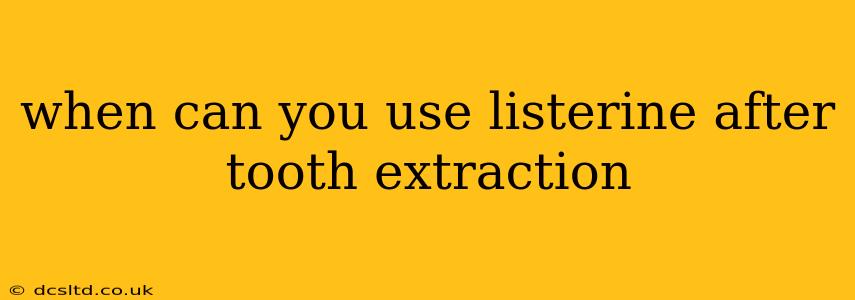Having a tooth extracted can be a bit of a rollercoaster. The pain, swelling, and the overall recovery process can be daunting. Many people wonder about their oral hygiene routine during this time, particularly when it comes to using mouthwash like Listerine. The short answer is: you should generally avoid using Listerine immediately after a tooth extraction. Let's delve into the reasons why and when it might be safe to resume using it.
Why Avoid Listerine Immediately After Tooth Extraction?
The primary reason you should avoid using Listerine right after a tooth extraction is because of its alcohol content. Alcohol is an irritant and can disrupt the delicate blood clot forming at the extraction site. This blood clot is crucial for healing and preventing a painful and potentially serious complication called "dry socket." A dry socket occurs when the blood clot dislodges or dissolves, exposing the underlying bone and nerve endings.
Furthermore, the potent antiseptic ingredients in Listerine, while effective against bacteria, can also irritate the sensitive gum tissues around the extraction site, hindering the healing process and increasing discomfort. The powerful swishing action required when using mouthwash could also dislodge the crucial blood clot.
How Long Should I Wait Before Using Listerine?
There's no single definitive answer to this question, as healing times vary between individuals and depend on the complexity of the extraction. However, it's generally recommended to wait at least 24-48 hours after the extraction before using any mouthwash, including Listerine. This allows the initial healing process to begin without disruption.
After this waiting period, it's advisable to consult your dentist or oral surgeon. They can assess your healing progress and advise on when it's safe to incorporate Listerine back into your oral hygiene routine. They might suggest a gentler mouthwash initially before you return to Listerine.
What Can I Use Instead of Listerine After Tooth Extraction?
During the initial healing phase, your dentist might recommend a saline rinse. This is a simple and effective way to clean your mouth without irritating the extraction site. You can prepare a saline rinse at home by dissolving a half-teaspoon of salt in a cup of warm water. Gently rinse your mouth with this solution several times a day.
Some dentists also recommend using a chlorhexidine gluconate mouthwash, which is a stronger antiseptic than Listerine but often prescribed for a limited duration post-surgery. Always follow your dentist's instructions regarding mouthwash usage.
Can Listerine Cause Dry Socket?
While Listerine itself doesn't directly cause dry socket, its alcohol content and potentially irritating ingredients can increase the risk of dislodging the blood clot, thereby contributing to the development of a dry socket. This is why caution is warranted.
When Can I Resume My Normal Oral Hygiene Routine?
Once your dentist gives you the all-clear, you can gradually resume your normal oral hygiene routine, including the use of Listerine. However, it's still advisable to be gentle around the extraction site for several weeks to ensure proper healing.
What Are the Signs of a Dry Socket?
It's crucial to be aware of the signs of a dry socket, so you can seek immediate dental attention if necessary. These signs include:
- Severe pain at the extraction site, often starting a few days after the procedure.
- A bad taste or smell in your mouth.
- Visible bone or empty socket.
Remember, every individual heals differently. Always consult with your dentist or oral surgeon for personalized advice on when it is safe to resume using Listerine or other mouthwashes after a tooth extraction. Their professional guidance will ensure the best possible outcome for your recovery.
